Python Full Stack

About Course
Enhance your learning experience by downloading our course browser for easy access to all your course materials and resources – Download Now
- If You Want To Take This Course Online , The Course fees Will be 25000 rupee/month.
- Course Duration – 8 months.
- (Strictly in MONTHLY system) and ONE-month advance, which will be, adjust in the last month of the course.
- Small group of Study (At-Least 10 students & At-most 15 students in ONE group).
- The Course Will be taken 2 Days/Week and 2 Hours /Day.
1. Introduction
1.1 Learning Programming
The Python Language
Why Use Python?
Python 2 or 3?
Enterprise Python
1.2 Python Community
Companies Using Python
Best Python Resources
Must-watch Python Videos
Podcasts
2. Development Environments
2.1 Text Editors and IDEs
Vim
Emacs
Sublime Text
PyCharm
Jupyter Notebook
2.2 Shells
Bourne-again shell (Bash)
Zsh
PowerShell
2.3 Terminal multiplexers
tmux
Screen
2.4 Environment configuration
Application dependencies
virtual environments (virtualenvs)
Localhost tunnels
2.5 Source Control
Git
Mercurial
3. Data
3.1 Relational databases
PostgreSQL
MySQL
SQLite
3.2 Object-relational mappers
SQLAlchemy
Peewee
Django ORM
Pony ORM
3.3 NoSQL
Redis
MongoDB
Apache Cassandra
Neo4j
3.4 Data analysis
pandas
SciPy & Numpy
3.5 Data visualization
Bokeh
d3.js
Matplotlib
3.6 Markup Languages
Markdown
reStructuredText
4. Web Development
4.1 Web Frameworks
Django
Flask
Bottle
Pyramid
TurboGears
Falcon
Morepath
Sanic
Other web frameworks
4.2 Template Engines
Jinja2
Mako
Django Templates
4.3 Web design
HTML
CSS
Responsive Design
Minification
4.4 CSS Frameworks
Bootstrap
Foundation
4.5 JavaScript
React
Vue.js
Angular
4.6 Task queues
Celery
Redis Queue (RQ)
Dramatiq
4.7 Static site generators
Pelican
Lektor
MkDocs
4.8 Testing
Unit testing
Integration testing
Debugging
Code Metrics
4.9 Networking
HTTPS
WebSockets
WebRTC
4.10 Web APIs
Microservices
Webhooks
Bots
4.11 API creation
API Frameworks
Django REST Framework
4.12 API integration
Twilio
Stripe
Slack
Okta
4.13 Web application security
SQL injection
Cross-Site Request Forgery
5. Web App Deployment
5.1 Hosting
Servers
Static content
Content Delivery Networks (CDNs)
5.2 Virtual Private Servers (VPSs)
Linode
DigitalOcean
Lightsail
5.3 Platform-as-a-Service
Heroku
PythonAnywhere
AWS CodeStar
5.4 Operating systems
Ubuntu Linux
macOS
FreeBSD
Windows
5.5 Web servers
Apache HTTP Server
Nginx
Caddy
5.6 WSGI servers
Green Unicorn
uWSGI
mod_wsgi
5.7 Continuous integration
Jenkins
GoCD
5.8 Configuration management
Ansible
Salt
5.9 Containers
Docker
Kubernetes
5.10 Serverless Architectures
AWS Lambda
Azure Functions
Google Cloud Functions
6. DevOps
6.1 Monitoring
Datadog
Prometheus
Rollbar
Sentry
6.2 Web App Performance
Logging
Caching
Web Analytics
7. Meta
Change log
About the author
What “full stack” means
Page Statuses
Future directions
